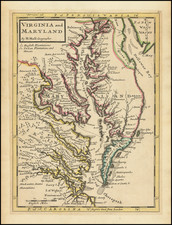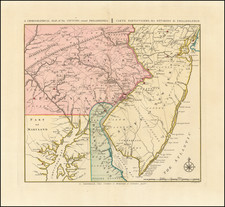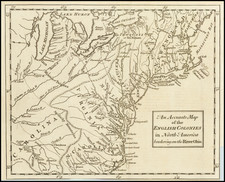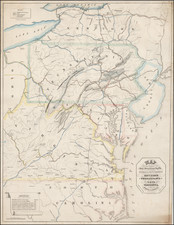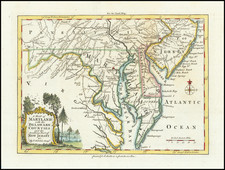The rare Faden-Hills plan of the Battle of Stoney Point (1779), a strategically critical engagement of the Ameircan Revolutionary War.
The Faden-Hills plan of the Battle of Stoney Point is an important American Revolutionary War plan, detailing the successful stealth attack led by American General "Mad Anthony" Wayne on the night of July 15/16, 1779, on the British fortifications at Stoney Point, which guarded the Hudson River about 35 miles north of New York City. While the daring operation was, in and of itself a modest affair, it both stunned the British and delivered a profound morale boost to the American side. More importantly, it cleared the Hudson Valley of a permanent British presence for the remainder of the war, and allowed a critical river crossing to be used by the French force of the Comte de Rochambeau on its march from Rhode Island to Virginia in the summer of 1781. Rochambeau's arrival in Virginia was a decisive event in allowing the Americans to defeat the British at the Battle of Yorktown in October 1781, an event that secured America's victory in the war and the independence of the new republic.
The map depicts both banks of the Hudson River, just below the town of Peekskill, with the river itself bisecting the map. This stretch of the river was long imbued with military significance, as here the Hudson narrowed between two promontories to form one of the best natural river crossings in the Hudson Valley, called King's Ferry. On the west bank is the hitherto British-held fortification of the Stoney Point, and on the eastern bank, at Verplank's Point, is Fort Lafayette (here labeled as 'Fort Fayette'), originally established by the Americans and named after the French general, the Marquis de Lafayette. The map captures the action of the battle that ensued, with American positions being represented by blue bars and the British forces by red bars. The table 'References to Stoney Point' notes the various American regiments and the positions of the British fortifications and heavy ordnance.
The Battle of Stoney Point & Historical Context
The year 1779 represented an uneasy time for both sides during the American Revolution, which could be likened to a 'calm before the storm'. Both sides were at something of a stalemate. The British had failed in all of their numerous attempts to strike a deathblow to George Washington's army. Their campaign of 1777-8, that led to the seizure of the American capital of Philadelphia, came to naught and ended in retreat. More worryingly, early in 1778, France actively joined the American cause. The British were, more or less, confirmed to their base of New York City and a handful of outposts in the region. This being said, the American side had much to fear. It was widely believed that the British could destroy Washington's army if it was ever lured into a field battle, and the juggernaut of the Royal Navy was something to dread. The Americans knew that the British would mount a severe reprise - it was only a matter of time (this turned out to be the 'Southern Strategy' campaign of 1780).
In 1779, the British Commander-in-Chief, General Sir Henry Clinton, focused on both securing the environs of New York City and pursuing means by which Washington would be forced out of the highlands to meet the British in a field battle. In May of that year, he dispatched a force up the Hudson and seized the American outposts at Stoney Point and Verplank's Point.
Washington, deeply worried that British control of the Hudson could physically sever New England from the rest of the American Colonies, and in doing so, strategically paralyze the American side, decided that recapturing these positions was an imperative. Washington selected Brigadier General "Mad Anthony" Wayne (1745-96) for the job. Wayne's nickname was given in honor of the often-frightening audacity he showed in battle. In reality, while a colorful and controversial figure, he was far from mad, and was one of the most skilled and calculating American commanders.
On the eve of Wayne's operation, a British force of around 600, under the command of Colonel Henry Johnson, occupied Stoney Point. While the position featured some small buildings and earthworks, it was not really a fortress in the conventional sense, as its main defense consisted of abbatis, formations of sharpened timber.
At around noon on July 15, Wayne's force of around 1,500 troops left Fort Montgomery, located upriver from Stoney Point, on a day long march towards their target. As shown on the map, they arrived at a position just to the west of Stoney Point at around dusk that evening. A key element of Wayne's plan followed intelligence that the British fortifications possessed a fatal flaw. The abbatis did not extend far into the beach along the riverbank, leaving the waterfront flanks of the fort completely unprotected at low tide (which that night occurred around midnight). Also in favor of the Americans was the fact that heavy cloud cover reduced the defender's visibility. The Americans attack would come with the complete element of surprise.
At around 11:30 PM, Wayne's force assumed attack positions, and from there moved with lightning speed. While a diversionary force distracted the British landward defenses, American detachments surged along the beach and into the fort's soft underbelly, their offensive positions represented by blue lines located immediately to the east of the fortifications. Shouting "The fort's our own!" the Americans gained total control of the fort after only 25 minutes. The Americans took all 546 of the surviving British defenders prisoner, and suffered only 15 casualties of their own. While not a grand endeavor, it was a textbook operation that won Wayne great praise from Washington and boosted American morale at a critical juncture. The only blemish on the affair was American General Robert Howe's failure to take the British positions at Verplank's Point. On the British side, the stealth capture of their outpost was met with horrified shock, although the British were gratified by the humane treatment that Wayne showed his prisoners.
The Faden-Hills plan was the only contemporary printed map of the battle. As noted by Ken Nebenzahl:
"Wayne's dramatic strike at Stoney Point raised patriot morale and gained new respect for the increasingly competent American army. Although issued after the war, this splendid engraving is the only one of this engagement published. The detailed rendering of the relief provides one with a dramatic picture of the setting of Wayne's stunning victory" (Nebenzahl, Atlas of the American Revolution).
Shortly after the battle, the Americans abandoned Stoney Point to focus their resources on shoring up their base at West Point, further to the south, along the Hudson. However, the great consequence of the Battle of Stony Point was that the British were discouraged from maintaining a permanent presence in the Hudson Valley above the immediate New York City area. This generally left the region in American control for the duration of the war, and so allowed Rochambeau's army to march to the aid of Washington during the decisive battle of the war at Yorktown.
The Story behind the Creation of the Map
The present map is a restrike made from the same copper-plate as used to print the original 1784 edition. The only notable difference between the original and the present edtion is the 1784 edition was printed on handmade laid paper, while the restrike was printed on machine made wove paper. The original edition of the map was issued by William Faden (1749-1836), the Geographer to the King, who ascended to the apex of the London map world based on his groundbreaking cartography of the American Revolution. Faden included the Stoney Point map in his exceedingly rare Atlas of Battles of the American Revolution (London, 1784), although some examples were also issued separately.
This present restrike was issued by James Wyld (Junior) (1812-1887), who succeeded his eponymous father as the official successor to Faden's firm and also served as the Geographer to Queen Victoria. Several of Faden's original copper-plates for his Revolutionary War maps were preserved in Wyld's shop, almost three generations after they were first used. As many of Faden's American battle plans were printed in limited quantities, the plates were still in relatively good condition. The American market still craved maps relating to the Revolutionary War, and as original maps from the period were already scarce, Wyld decided to issue restrikes from the original plates. The sharp printing quality of the present restrike is evidence of the fact that Faden's Stoney Point plate remained in good condition.
Faden based his Stoney Point map on a manuscript plan by John Hills, one of the most talented and prolific cartographers of the Revolutionary War, and a direct eyewitness to many of the events captured by his maps. John Hills (fl. 1777-1816) served as ensign in the 38th and later as a lieutenant in the 23rd regiment. Hills's abilities were greatly valued by his superiors even though his mercurial personality frequently led him into violent altercations with fellow officers and civilians alike.
While serving in the Philadelphia Campaign of 1777-8 and later actions in the New Jersey theatre, Hills drafted a magnificent series of manuscript battle plans, and larger regional campaign maps. It would appear that he was apprised of the most advanced civilian surveys, having had access to the original maps contained in the archives of the Proprietors of East Jersey, which had been seized by the British from the provincial capital, Perth Amboy. Hills also seems to have been in contact with various local surveyors in both New Jersey and Pennsylvania. His greatest work was the manuscript atlas of 20 maps of parts of New Jersey he made in 1780 for the British Commander-in-Chief Sir Henry Clinton, now preserved in the Library of Congress. From 1779-80, Hills conducted a number of surveys for Clinton in the regions around New York City, notably in the Hudson Valley.
Following the war, Hills settled in Philadelphia, and existing manuscripts shows that as early as 1788, he was working as a professional draftsman and surveyor. In 1796, with the support of Philadelphia's mayor, Matthew Clark, Hills completed the most important survey of the city of the Post-Revolutionary generation. This was published as A Plan of the City of Philadelphia and its Environs (London, 1798), and is today a landmark of early American urban cartography.
The Faden-Hills plan of Stoney Point not only documents an important event of the American Revolution, but is also a fascinating artifact relating to how one of the world's leading mapmakers revived maps to satisfy a new generation's desire to explore the American Revolutionary era.
William Faden (1749-1836) was the most prominent London mapmaker and publisher of the late-eighteenth and early-nineteenth centuries. His father, William Mackfaden, was a printer who dropped the first part of his last name due to the Jacobite rising of 1745.
Apprenticed to an engraver in the Clothworkers' Company, he was made free of the Company in August of 1771. He entered into a partnership with the family of Thomas Jeffreys, a prolific and well-respected mapmaker who had recently died in 1771. This partnership lasted until 1776.
Also in 1776, Faden joined the Society of Civil Engineers, which later changed its name to the Smeatonian Society of Civil Engineers. The Smeatonians operated as an elite, yet practical, dining club and his membership led Faden to several engineering publications, including canal plans and plans of other new engineering projects.
Faden's star rose during the American Revolution, when he produced popular maps and atlases focused on the American colonies and the battles that raged within them. In 1783, just as the war ended, Faden inherited his father's estate, allowing him to fully control his business and expand it; in the same year he gained the title "Geographer in Ordinary to his Majesty."
Faden also commanded a large stock of British county maps, which made him attractive as a partner to the Ordnance Survey; he published the first Ordnance map in 1801, a map of Kent. The Admiralty also admired his work and acquired some of his plates which were re-issued as official naval charts.
Faden was renowned for his ingenuity as well as his business acumen. In 1796 he was awarded a gold medal by the Society of Arts. With his brother-in-law, the astronomer and painter John Russell, he created the first extant lunar globe.
After retiring in 1823 the lucrative business passed to James Wyld, a former apprentice. He died in Shepperton in 1826, leaving a large estate.










